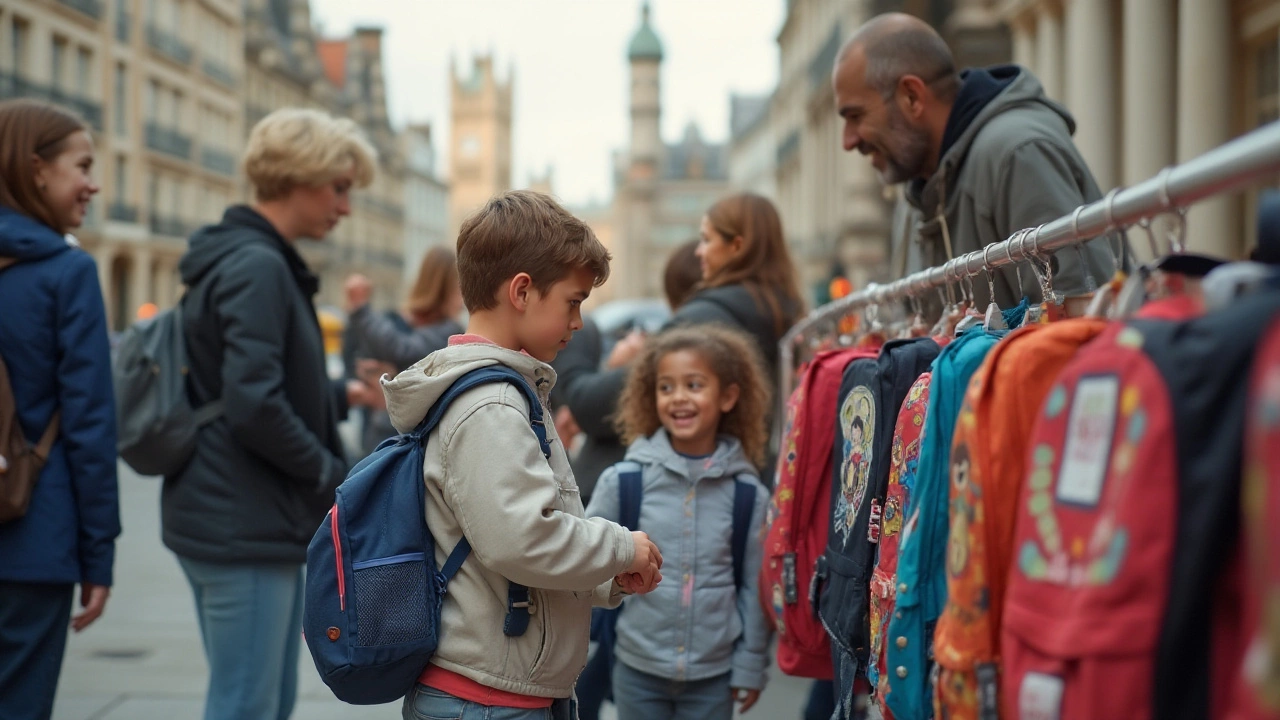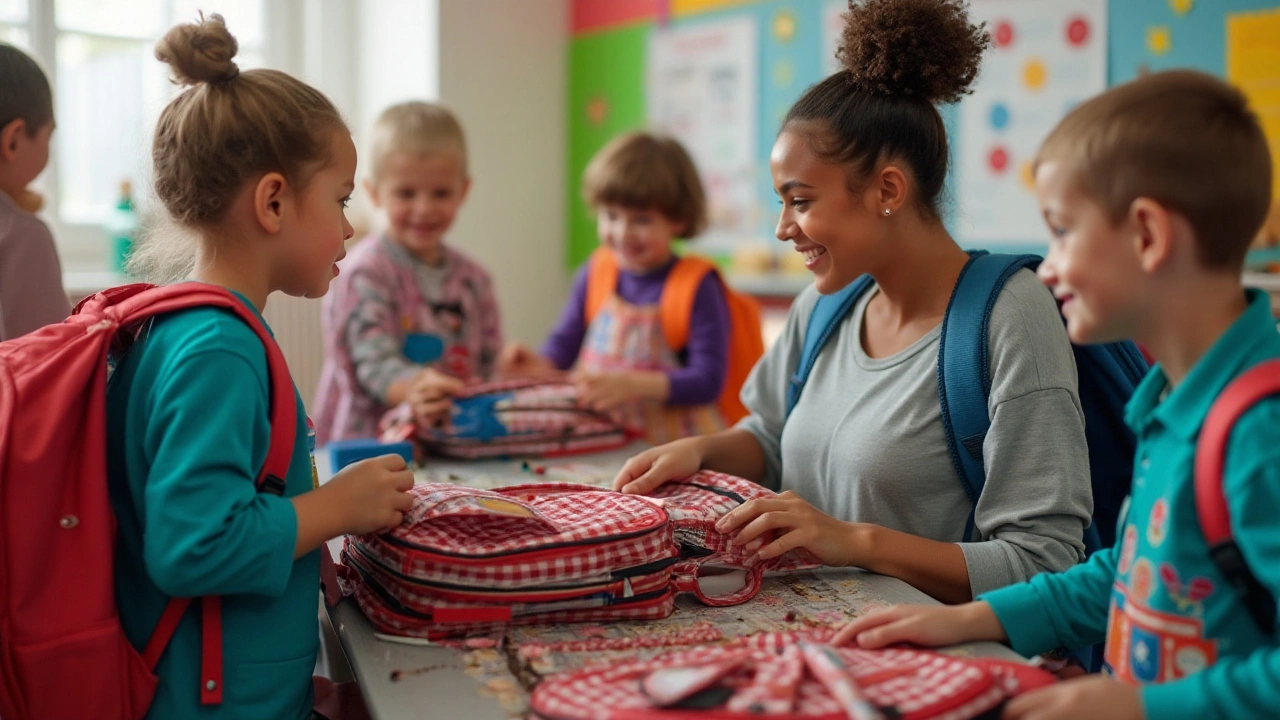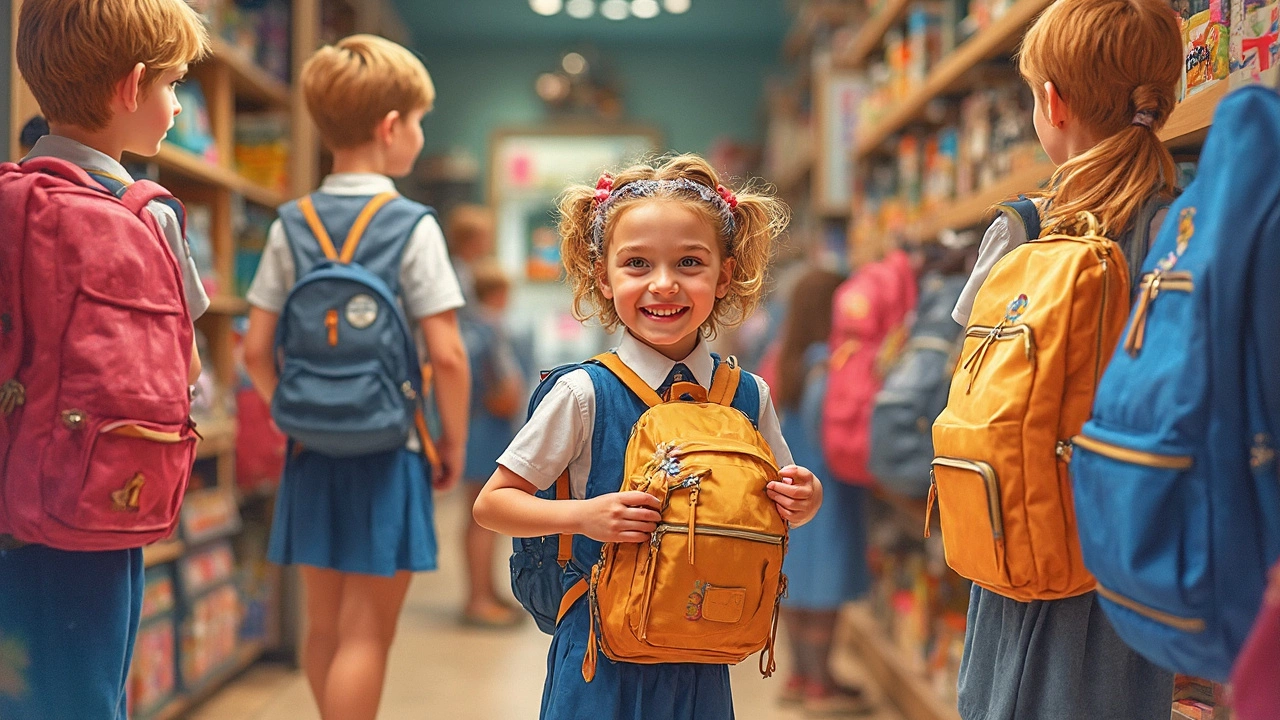Choosing the Perfect Backpack for Your Child’s Elementary School Journey

Choosing the right backpack for your child's elementary school years is much more than picking their favorite color or style. It's about ensuring they have a comfortable and practical tool that supports their educational journey. As children grow, their needs and the demands of their school work change, so too must their backpacks.
In this article, we delve into the specifics of what makes a great backpack for elementary students. From understanding how size affects a child's health and learning to highlighting must-have features and ergonomic designs, we provide an insightful guide to help parents make informed decisions. Let's embark on this path to finding a backpack that balances function and fun, ultimately enhancing your child’s school experience.
- Why Backpack Size Matters
- Ideal Backpack Dimensions for Kids
- Features to Seek in a Good Backpack
- Ergonomic Design and Its Importance
- Personalizing Your Child's Backpack Experience
Why Backpack Size Matters
The size of a backpack may seem inconsequential at first glance, but for an elementary school child, it plays an essential role in their daily life. Understanding why backpack size matters involves more than just ensuring a child can fit their books and supplies inside; it's about safeguarding their health and fostering an environment that supports their learning. Schools may provide lockers or cubbies, but most of the transportation of items relies on these trusty bags. The wrong size can lead to discomfort, long-term health issues, and even impede on a child’s mood and extended learning abilities.
One key consideration is that a backpack that is too large can encourage a child to carry more than they need, leading to excessive weight. According to the American Academy of Pediatrics, a child's backpack should not weigh more than 10% to 15% of the child's weight. A bag that is too big for a child can encourage stuffing unnecessary items, contributing to a heavyweight that they carry every day, possibly affecting their posture. Posture-related issues are not just physical ailments but can affect concentration, energy levels, and overall wellness during the school day. A preferable size is around half their torso length and should sit snugly on their back, close to the body for the optimal balance and ease of movement.
The choice of the school bag size also makes a statement about functionality versus aesthetics. Parents often face challenges balancing a child's immediate preference for a favorite cartoon character plastered on a sophisticated oversized pack and the practical aspects a parent must consider. It's crucial to look at elements like sturdiness, the flexibility of compartments, ease of cleaning, and additional pockets that make the bag both attractive and practical.
"Choosing the right-sized backpack is crucial for child's health and quality of life," shares Lisa Morgan, a pediatric chiropractor with over two decades of experience in children’s health, "It ensures that our young ones don't develop early habits that could lead to chronic pain issues."Understanding the load these little shoulders can bear reasonably ensures that something as familiar as a backpack doesn’t turn school days into exercise sessions.
Another aspect inherent in selecting the correct backpack size lies in safety. A well-selected backpack with proper adjustments decreases the risk of tripping over loose straps or awkward bag protrusions that can catch on objects like bus door handles or school lockers. Children are taught to move swiftly and safely through their environments, and their backpacks ought to complement this training rather than hinder it. Having the right-sized backpack promotes not just the safety in transportation but confidence and independence in children as they learn to manage their own belongings effectively. This attention to ergonomic design and function empowers children and sets them on a path to cultivate good organizational habits early on, benefiting them well beyond their elementary school years.
Ideal Backpack Dimensions for Kids
When it comes to choosing the right backpack for elementary school children, size is crucial for their comfort and health. Selecting a backpack that is too large can cause children to lean forward to counterbalance the weight on their backs, which can lead to posture problems and back pain. Conversely, a pack that is too small may not fit all of their necessary school supplies, leading to unnecessary stress and clutter. According to child health experts, a child's backpack should generally be no wider than their torso, and not hang more than four inches below the waist. This ensures that the backpack sits snugly and does not sway, which could cause strain over time.
Typically, for younger children in kindergarten through second grade, a backpack with a capacity of about 15 to 20 liters is adequate. As they progress to third through fifth grade, a slightly larger size may be needed, often around 20 to 30 liters, to accommodate heavier books and more school materials. It's essential to take into account both the capacity and physical dimensions to maintain a balance between space and comfort. One practical tip is to look for backpacks that feature adjustable, padded shoulder straps, which help distribute weight evenly and lessen the burden on a child's developing body.
Considering the Load
Experts recommend that a child's backpack should not weigh more than 10-15% of their body weight. This balancing act means that parents should be mindful not just of the bag's size but what goes into it. For instance, a child weighing 50 pounds should ideally carry a backpack that weighs no more than 5 to 7.5 pounds when packed. As Dr. Karen Jacobs, occupational therapist, notes, "Choosing the right-sized backpack is essential for your child's spinal health and comfort in school."
"Choosing the right-sized backpack is essential for your child's spinal health and comfort in school." - Dr. Karen Jacobs
Additionally, many backpacks now come with compartments that help children organize their belongings, reducing the need for overpacking and helping to distribute weight evenly. Pair this with waist and chest straps, and you have a combination that supports healthy posture. Remember, even if a backpack is designed for children and marketed as such, it's critical to check these aspects personally, ensuring that they align with your child's needs and school requirements.
When Size Meets Style
While practicality is paramount, the style holds a significant place in choosing a backpack your child will love. It's about striking the right balance between a bag that fits well and one that your child is excited to carry. A backpack that comes in their favorite color or features beloved cartoon characters might motivate them to care more about organizing their belongings and wearing it properly. Although dazzling designs can be enticing, remind your child to consider function in addition to appearance.
An interesting trend is seen in backpacks with reflective material or panels, which enhances visibility and safety, especially during early morning or late afternoon travels. Whatever the choice, make sure it stands the test of both durability and your child's evolving taste, as there can be few quicker ways to the morning meltdown than a backpack new one week and despised the next. The 'perfect' elementary school backpack finds that harmony of being supportive, sensible, and suitably stylish for your young scholar.

Features to Seek in a Good Backpack
When searching for the perfect elementary school backpack, it's crucial to focus on features that emphasize both functionality and comfort. Let's start with the material. Opt for durable fabrics such as high-density nylon or polyester, which not only ensure longevity but are also resistant to water. This can protect your child’s belongings from unforeseen weather changes. Moreover, consider waterproof zippers and reinforced stitching, which add an extra layer of durability to the backpack.
The design of the backpack also plays a vital role in determining comfort. Look for ones with padded shoulders straps, which evenly distribute weight and reduce the risk of shoulder and neck strain. These straps should be wide and adjustable, allowing them to fit snugly without slipping off small shoulders. Many experts recommend that the backpack should not weigh more than 10% to 15% of the child’s body weight, ensuring it doesn’t become a health burden. A school bag size with a padded back panel can also enhance comfort and promote good posture.
On the organizational front, multiple compartments are indispensable. A well-designed backpack should have at least two main compartments for books and larger items, and smaller front pockets for smaller school supplies. Mesh side pockets can be an excellent addition for holding water bottles or snacks, keeping them accessible but separate from textbooks and homework. An organizer panel inside can help kids develop a sense of organization early, keeping pens, pencils, and erasers within easy reach.
Safety and Convenience
Safety features should not be overlooked. Reflective patches or trim on the backpack can enhance your child's visibility during those early morning or late afternoon walks to and from school. Some backpacks come with a detachable waist belt, which, if used properly, further improves weight balance by transferring some of the load to the hips.
"A good backpack is more than just about carrying books; it's about making sure children have a tool that takes care of their health,” mentions pediatric chiropractor Dr. Samantha Wilson, emphasizing the importance of ergonomic features.
Finally, the ease of cleaning is another aspect that matters, especially when dealing with spills or ink stains that are inevitable with school children. Machine-washable backpacks are rare but immensely useful, otherwise, ensure the fabric allows for easy spot cleaning. Keeping these crucial features in mind will guide parents towards selecting a backpack that aligns with the demands of school life while prioritizing their child’s comfort and health.
Ergonomic Design and Its Importance
When it comes to choosing a elementary school backpack, ergonomic design plays a crucial role in ensuring your child’s health and comfort. At such a tender age, children are still developing their posture and balance, which makes it imperative to choose a backpack that does not put unnecessary strain on their growing bodies. Research has shown that ill-fitting backpacks, especially those heavy and improperly worn, can lead to chronic back pain and posture problems. In fact, a well-designed ergonomic backpack should more effectively distribute the weight of the backpack contents, reducing strain on the spine and shoulders. This is something all parents should consider seriously when selecting a school bag for their young ones.
To evaluate if a backpack is ergonomic, check for wide, padded shoulder straps as these are essential for weight distribution. Narrow or unpadded straps can dig into shoulders, causing pain and discomfort. Adjustable straps are another important feature; they allow for a customized fit, ensuring the backpack sits comfortably on the child's back, snug against the body. Equally important is the presence of a padded back, which enhances comfort and protection against sharp edges of books and supplies inside the bag.
Load distribution is critical in kids backpacks. A proper ergonomic design includes a waist or chest belt which helps spread the weight evenly across the torso, preventing the backpack from swaying while the child moves. This also helps stabilize the load, making it easier for kids to carry the backpack without feeling off-balance, which is a common complaint among younger students. According to a study published in the Journal of School Health, children carrying more than 10% of their body weight in their backpacks experience more discomfort, highlighting the importance of not just ergonomic design, but also ensuring the load is appropriate for the child’s size and strength.
Moreover, an ergonomic backpack often includes multiple compartments that can help your child stay organized while also distributing weight evenly. This feature is practically essential since it allows heavier items to be placed closer to the back, reducing the pull on the shoulders. Colorful and labeled compartments make organization easier and more intuitive for kids, encouraging them to pack their backpacks in a balanced manner.
A quality school bag size involves considering the backpack’s overall volume in relation to the child’s height and width. In general, the top of a backpack should not extend higher than the shoulders, and the bottom should not go lower than the hips. A properly sized ergonomic backpack that’s fitted correctly helps maintain the child’s natural posture, which is vital in preventing injuries and ensuring comfort. Ultimately, investing in an ergonomic backpack not only enhances a child’s comfort but also teaches them valuable lessons about self-care and the importance of health, a sentiment echoed widely by health professionals, including the American Academy of Pediatrics.

Personalizing Your Child's Backpack Experience
Personalizing a backpack goes far beyond aesthetics; it's about crafting a unique space that reflects your child's personality and preferences while considering practical needs. This touch of uniqueness not only makes the backpack special but also encourages children to stay organized and take responsibility for their belongings. To start, consider adding personalized name tags or patches that showcase your child's interests, whether they are passionate about their favorite animal, a beloved superhero, or a dream career such as becoming an astronaut. Customization can turn a generic school bag into a cherished companion, fostering a sense of individuality and pride in ownership.
Another effective way to add personality is through keychains or charms that offer a glimpse into your child's world. Allow them to choose a few small accessories that can be swapped out depending on their mood or upcoming holiday themes. It's also beneficial to incorporate educational elements; attach a small world map or a mathematical tool, like a times tables chart, subtly embedding learning into their daily routine. Statistics show that children who feel a personal connection to their educational tools are more engaged with their studies, as suggested by educational psychologist Sarah Jones.
"When children personalize their belongings, they tend to develop a stronger sense of ownership and responsibility towards them," she notes.
Fostering an organized backpack also comes with its advantages. Begin by considering the internal organization of the school bag. Look for bags with multiple compartments that allow for easy sorting of books, stationery, and personal items. Adjustable straps and ergonomic designs are not just about comfort; they are about supporting a child's physical health. Organizing by color or using labeled pouches can also make morning rushes more manageable and teach important organizational skills. This approach aids in categorizing belongings, which can enhance memory retention and retrieval skills, according to a study published in the Journal of Child Psychology.
Adding a personal note or a small unexpected treat in their lunch compartment now and then can also brighten a child's day. This small act can have a significant impact, reminding them of home and comfort, especially in new or challenging school environments. Additionally, involving children in choosing their kids backpacks and the personalization process can be an empowering experience that reinforces decision-making skills. Keep in mind that elementary-aged children thrive on creativity and exploration, so providing them avenues to express these through their backpacks can reinforce positive self-expression and self-esteem.
Turning the backpack into a memory book can also be a delightful endeavor. Encourage them to attach a small diary or an autograph book to the elementary school backpack where they can jot down thoughts, ideas, or fun memories with friends. This element of personalization can help children articulate their experiences, making each day a step toward emotional development. Cultivating such a personal space within a backpack enriches the school experience and prompts conversations about their school day, bridging home and school life seamlessly.


